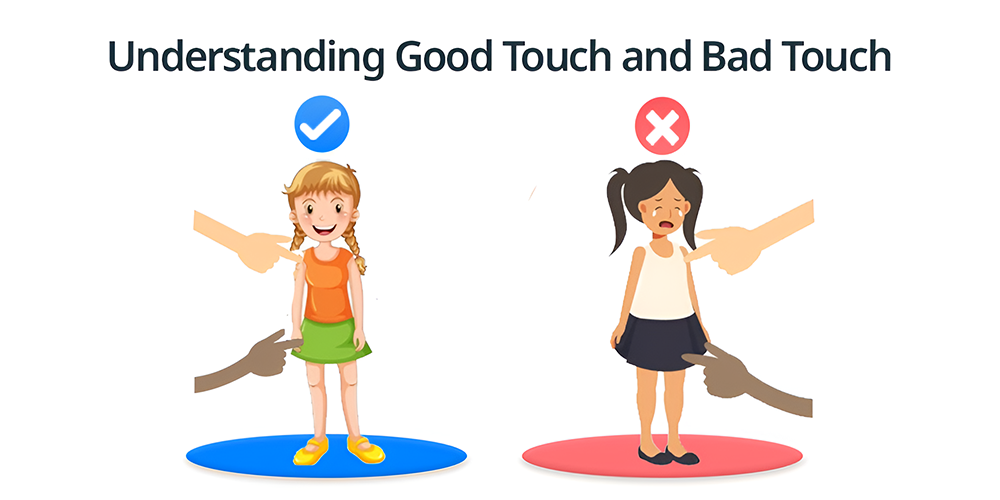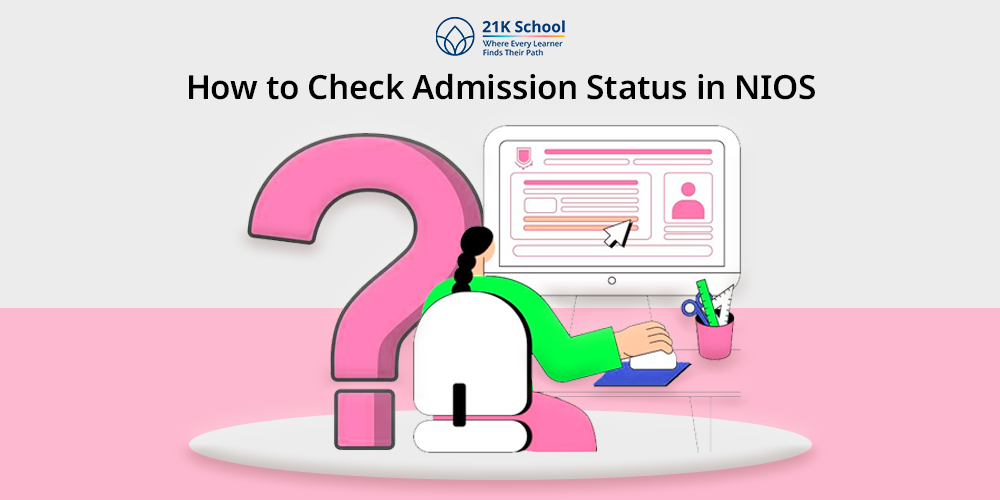
Contents
- What is Bad Touch and Good Touch?
- 10 Ways How to Teach Good Touch and Bad Touch
- Age-Appropriate Ways to Teach Children
- Body Safety Rules Every Child Should Know
- 1. Naming Body Parts
- 2. Appropriate and Inappropriate Touch
- 3. Identify Safe And Unsafe Situations
- 4. Boundaries
- 5. Don’t Keep Secrets
- 6. Know Your Name, Number & Address
- 7. Early Warning Signs
- 8. Never Go Anywhere With A Stranger
- 9. No Body Secrets
- 10. No Pictures Of Private Parts
- 11. The Difference Between Secrets And Surprises
- 12. Uncomfortable Feelings
- 13. Be Clear On What’s Private
- 14. Difference Between Good And Bad Touch
- 15. Discourage Secrets
- Examples – Difference between Good Touch and Bad Touch
- How Parents & Teachers Can Start the Conversation?
- Resources for Teaching Kids About Body Safety
What is Bad Touch and Good Touch?
Individuals’ body safety is crucial and education about it helps in distinguishing good touch from bad touch.
What Is a Good Touch?
A “good touch” is positive physical contact that makes someone feel safe, comfortable and in a secured environment.
It’s generally associated with affection, care, and support from trusted individuals.
- Positive and Safe: A good touch always supports both emotional and physical well-being.
- Examples: Hugs from parents, a high-five from a teacher, holding hands while crossing the street.
- Typically from Trusted Individuals: It can be between family members, friends, colleagues or facilitators in safe situations.
What Is Bad Touch?
Bad touch is any physical contact that makes a person, especially a child, feel uncomfortable, scared or unsafe.
- Negative and Uncomfortable: Bad touch leaves a kid feeling anxiety, confused, scared or uneasy.
- Examples: If an individual touches other body parts in a bad way, forcing unwanted hugs or kisses, or making them uncomfortable especially alone.
- Can Come from Anyone: Bad touch can come from any individual even those who are known or trusted.
- Teaches Children to Say No: Children must know to say “NO”. They have the right to reject and report any touch which is uncomfortable and inappropriate.
10 Ways How to Teach Good Touch and Bad Touch
Teaching kids everything about good touch and bad touch is essential for their growth and development.
This body education includes explaining safe and unsafe physical contacts. This helps them to recognize and respond to inappropriate environments and foster open communication.
Here’s 10 ways to teach good touch and bad touch one must know:
1. Start Early
Starting early and using age appropriate ways are crucial to teach good touch and bad touch especially to children.
Facilitators can teach them about body autonomy and empower them to recognize and respond to inappropriate touch. While bathing or playing, discuss body parts and their uses.
2. Use Clear and Simple Language
Use clear and simple language to teach about body parts and it’s a good or bad touch experience.
This will reduce confusion and ensure adults take their concerns seriously.
3. Empower Children to Speak Up
One needs to teach them to trust their instincts which empower children to speak up in wrong situations.
Build their confidence through affirmations like teaching them to say “No” when you are uncomfortable in the environment.
4. Explain the Concept of Private Body Parts
Introduce your children about the body parts especially private parts explain the concept how one can touch wrongly.
Also explain that their privacy should be respected and that they should respect others’ boundaries too no matter whether the opposite person is known or unknown.
5. Role-playing
For teaching children about good touch and bad touch, engage them in role-playing scenarios. In roleplay they can practice identifying and responding to uncomfortable situations.
This will help them to understand the boundaries and look for help whenever needed.
6. Books and Educational Resources
Teaching good and bad touches are crucial for child safety. There are a lot of ways to do so.
For example, books, videos, and various activities can guide children to understand personal boundaries, recognize unsafe situations, and develop the confidence to speak up.
Read on to learn more about Top 10 Benefits of Reading Books
7. Bring Clarity
Bringing clarity in children’s minds is important for parents, facilitators and elders.
Teach them secrets that make them feel scared, confused, or uncomfortable should never be kept. Also, let them know the rule that “We don’t keep secrets about touches or feelings. Always speak up about the uncomfortability”.
8. Body Language
Teach kids to recognize body language. This helps children tune in to their instincts and emotional responses.
It’s okay to say “I don’t like that or Stop”. Guide them to recognizing the red flag especially when it happens multiple times.
9. Enact It Out
Parents in home and facilitators in the classroom can enact it out in daily situations.
For example, go with real-life opportunities like when your kid shakes hands or hugs a friend, praises them and asks to be can so his or her friend is comfortable.
10. Safe Environment
The most essential tool is trust. Create a safe environment for sharing everything or anything for example telling about wrongful touch.
This will encourage open conversations without shame or punishment. If a child shares something uncomfortable, stay calm, listen, and validate their feelings. Let the child know you believe it.
Age-Appropriate Ways to Teach Children
Teaching about good touch and bad touch from a young age (between ages 3 to 4) which helps them to understand and process information differently at each developmental stage.
This will ensure that each kid gets the message at the right time.
Breakdown by Age Group:
i) Age 3–5: Private Parts, Basic Body Rules
- Focus on Private Parts: One must introduce the concept of private parts with their anatomical names like genitals, breasts, and buttocks.
Explain these parts should only be touched by themselves, parents or doctor for hygiene or medical reasons. Also, with good intentions.
- Use Simple/Easy Language: Sometimes the terms such as “good touch” and “bad touch” can be confusing for kids to understand the difference.
Instead, using phrases like “safe touch” and “unsafe touch” or “comfortable touch” and “uncomfortable touch” Can be beneficial. However, each learning style is different so try that suits best.
- Basic Body Rules: Teach kids that their body belongs to them. Also, they have the right to say NO to any bad touch that makes them uncomfortable.
- Role-playing: Parents can teach children through role-playing at home where they can practice saying “no” to unwanted touches and seeking help from trusted adults.
- Identify Trusted Adults: One should guide kids to identify a few safe people they can talk or connect instantly. If they feel uncomfortable or unsafe then reach out to parents, grandparents, teachers, or close family friends.
ii) Age 6–9: Safe/Unsafe Touch Examples
- Reinforce Body Autonomy: Introducing body parts at an early age is crucial but one needs to continue to reinforce body autonomy to make sure kids find out any touch that makes them uncomfortable, even from people they know.
- Teach About Healthy and Unhealthy Secrets: Let them know that it’s ok to have a secret which makes them happy but anything that scare or feel uneasy should be shared with the most comfortable person. They are unhealthy secrets and adults can protect you to get out of the situation.
- Discuss Stranger Danger: Sometimes a stranger can be dangerous outside the home such as in a park or school. It’s essential to teach children about stranger danger and how to avoid situations that could be unsafe.
- Discuss Safe/Unsafe Touch Examples: Discuss safe and unsafe touch with examples to help them understand that some touches are okay while others are not.
Like hugs and kisses from loved ones is a good touch and touching private parts or being forced to touch someone else’s private parts is a bad one.
iii) Age 10+: Consent and Peer Interactions
- Consent and Peer Interactions: At age between 10 and above one needs to focus on building consent and social boundaries.This can be done by talking about peer pressure, internet safety, and respect in friendships and relationships.
- Discuss Digital Boundaries: Discuss digital boundaries such as inappropriate photos, chats are important.
Introduce the idea of mutual consent, especially as puberty begins. Parents can promote healthy communication and respect for others’ limits.
Body Safety Rules Every Child Should Know
Every child should know and understand basic body safety rules to protect themselves from harm.
This will help them to know their bodies are their own property. And they have the right to say no to unwanted touch.
Let’s understand 15 body safety rules every child should know:
1. Naming Body Parts
Teaching kids the correct names for their body parts, including private parts is important for their safety.
This education helps them to speak up and seek help when needed. It also guides kids to understand what is considered safe and unsafe touch.
2. Appropriate and Inappropriate Touch
Explain to kids what touch can feel “good” such as a hug or pat by someone they trust versus touch that doesn’t feel right.
Appropriate touch includes high-fives, comfort handshakes from a known person while inappropriate touch like making you feel embarrassed, uneasy, or causes fear.
3. Identify Safe And Unsafe Situations
Children must identify safe and unsafe situations to handle it appropriately.
This means understanding the concept of “good touch” and “bad touch,” knowing when and how to say “no,” and identifying trusted adults to confide in if they feel unsafe.
4. Boundaries
One needs to guide the boundaries as invisible lines around a child’s body and personal space.
Each individual must respect individual boundaries and personal space regardless of age, color or relationship.
5. Don’t Keep Secrets
Kids are sometimes asked to keep things their friends or siblings did a secret. They need to understand good surprises and harmful secrets.
However, it’s important they know that if they ever feel something was dangerous, harmful, or really wrong, they should feel safe to tell. Ask them to not keep secrets when they’re uncomfortable.
6. Know Your Name, Number & Address
Children should know their full name, parents’ names, a parent’s or guardian’s contact number, and their home address.
This knowledge will ensure that kids stay safe and look for help in case of emergencies or if they become separated from their parents.
7. Early Warning Signs
Body safety rules are important for everyone from childhood. It guides everyone to recognize and respond to unsafe situations.
Early warning signs include a sweaty palms, tightening throat, freezing up, racing heart or a sick stomach when feeling unsafe. These signals are an act of wrong practice.
8. Never Go Anywhere With A Stranger
Never go anywhere with a stranger no matter what the situation or environment is.
Let them know someone is waiting or you don’t have time or your aunt is calling for some important work. a kid should make a distance or reach a known place for help.
9. No Body Secrets
These are secrets about private or personal body matters. No one should ask a child to keep parts of their body hidden or their touch or interactions off-limits for discussion.
10. No Pictures Of Private Parts
Educating kids that no pictures of private parts is considered good. For example, anyone asking to take them needs to be told “NO” and reported.
Teach them not to share or show any kind of pictures or videos.
11. The Difference Between Secrets And Surprises
Secrets happen when someone wants to stay hidden, possibly because they are uncomfortable or cause worry while surprises are meant to be revealed and bring joy.
Kids from a young age should recognize the difference and understand that they should never feel obligated to keep secrets especially in tense situations.
12. Uncomfortable Feelings
Bad touch always puts in an uncomfortable feeling or situation. Teach them to trust their instincts in these environments.
Uncomfortable feelings include shivering, tummy ache, and listening to these cues can prevent harm before it escalates.
13. Be Clear On What’s Private
Body privacy means only the individual himself permits who sees or touches the body.
Private parts are private only in exceptions bath supervision by trusted adults, routine medical exams by appropriate professionals.
14. Difference Between Good And Bad Touch
Good touch refers to respectful, caring physical contact like hugs from loved ones or high-fives from friends.
On the other hand, bad touch is any unwanted, uncomfortable, or forceful physical contact, particularly to private body parts.
15. Discourage Secrets
Discouraging secrets, especially from children, involves creating an environment of open communication and trust where they feel safe to share any concerns or experiences, regardless of whether they feel it’s a “secret” or not.
Examples – Difference between Good Touch and Bad Touch
To understand good touch and bad touch one needs to know the example difference between both.
Here’s a more detailed breakdown:
| S.No. | Situations | Good Touch | Bad Touch |
| 1. | Hug from An Adult | A warm hug from her dad or mom when falling from a tree is a good touch. | A tight hug from a friend that makes her feel embarrassed or ashamed in a public place. |
| 2. | High‑five or Pat on Back | Coach gives a congratulatory pat in back after soccer practice or winning a match. | Coach touching near a private area “just to fix uniform” or “inappropriate touch in the back”. |
| 3. | Hand‑holding in Emergencies | Parent holding child’s hand crossing a street or cousin’s hand hold while playing for safety. | Stranger or someone unknown holding hands and resisting to leave or then asking the child to go with them. |
| 4. | Doctor’s Check‑up with Consent | Doctor asks before examining, especially in the presence of parents. | Doctor or adult pretending to check, touching child’s genitals at public or private areas like washrooms without permission. |
| 5. | Comfort Cuddle after Bad Dream | Comforting cuddle from known adult before telling child it’s okay. | Any adult touching under or over the clothes when child feels upset, without clear reason. |
| 6. | Quick Kiss on Cheek | Grandma or cousin kisses child to say goodbye in public place. | Adult kissing child’s inappropriately, against their feelings or telling them not to tell or keep a secret. |
| 7. | Teacher helps Tie Shoe | Teacher helps fix shoelace in front of classroom as a responsibility. | Teacher kneeling behind child, touching upper thigh or groin by accident or intentionally. |
| 8. | Birthday surprise | Fun peek-a-boo challenge with parent or friends at birthday party can be existingly good. | A friend telling “don’t tell anyone what we did in the backyard” and child feels uneasy is a bad thing. |
How Parents & Teachers Can Start the Conversation?
Connecting with kids through positive and productive conversations will be more helpful. Teachers and parents both can initiate with praise and positive observations.
Here’s how parents and teachers starts the conversation:
Teachers:
- Start with Positivity: As a teacher one must start positive conversations about the student. For example their strengths or good behavior or interaction you observed.
- Share Observations: Give various demos or share observations while student’s learning. These observations are related to both positive and negative areas needing attention.
- Ask Open-Ended Questions: Encourage parents to share their perspectives by asking open-ended questions.
- Listen Actively: Listen actively to what parents say. Must ask clarifying questions, and show that you value their input in students’ lives.
- Offer Support and Solutions: If concerns arise, both parents and teachers should work together to develop strategies for addressing them.
- Be Proactive: In depth communication between parents and teachers not only in problematic situations but also in normal follow ups and sharing positive updates build a strong relationship.
Parents:
- Ask Open-Ended Questions: Connect with the class teacher to know the child’s progress. Also, ask for suggestions on how to support kids learning at home.
- Be Open to Feedback: Be open to feedback from the teacher’s observations and be willing to work together to find solutions.
- Parent and Teacher Conferences: Parent and teacher conferences are ideal. Both can also attend other school events to show your engagement and support for your child’s education.
- Communicate Regularly: As a parents kids and their protection is your responsibility. So, don’t hesitate to reach out to the councillor or teacher with any questions or concerns that may arise.
- Reinforce Positive Communication at Home: Encourage your child to be open and honest with you. Reinforce positive communication at home about their experiences at school and with their teachers will make you aware.
By this way parents and teachers play a crucial role in kids’ safety. Both together can ensure the objective is fulfilling.
Resources for Teaching Kids About Body Safety
For teaching kids effectively about body safety, the 21st century resources are important. One should focus on clear, age-appropriate language.
Resources should also address healthy and unhealthy secrets, safe and unsafe touching, and the importance of having a trusted network of adults to turn to.
Key areas to focus on when teaching body safety tips to kids:
- Books: There are several ways to educate your kids such as books. One can avail those which address body safety and consent in age-appropriate ways.
Books such as “My Body! What I Say Goes!” and “No Means No“.
- Other Educational Materials: Other educational materials include videos & apps. Different kinds of animated clips on good touch or bad touch scenarios ideal for 4 to 8 years kids.
Apps such as Buddy App for teens to replay boundary-based scenarios and quick help calling.
- Engage in Activities: Engaging activities to reinforce body safety concepts is one of the resources for teaching kids about body safety.
For example, role-playing, games, and songs ensures student engagement.
- Teach Safety Rules: Explain boundaries and teaching safety rules helps kids to identify the good touch and bad touch easily.
It involves educating them about their bodies, appropriate touch, and how to recognize and respond to unsafe situations.
- Teach through Different Learning Styles: There are many other ways through which parents at home and teachers at school teach about body safety.
For example, storytelling, open communication, online programs etc are good choices one must follow for better results.



